Whether a South Indian or no, an Idli is a favorite with most of us Indians. It is tasty, filling as well as the perfect dish when it comes to having just the right kind of nutrition. That’s why a favorite choice of breakfast, across the country too. On this post, I have shared one of my favorite idli variations, the Rava Idli. This Suji Ki Idli recipe gives incredibly light, soft and sumptuous idlis. For this instant idli recipe, I have found the perfect combination of ingredients that result in savory cakes that are fluffy, moist and delicious.
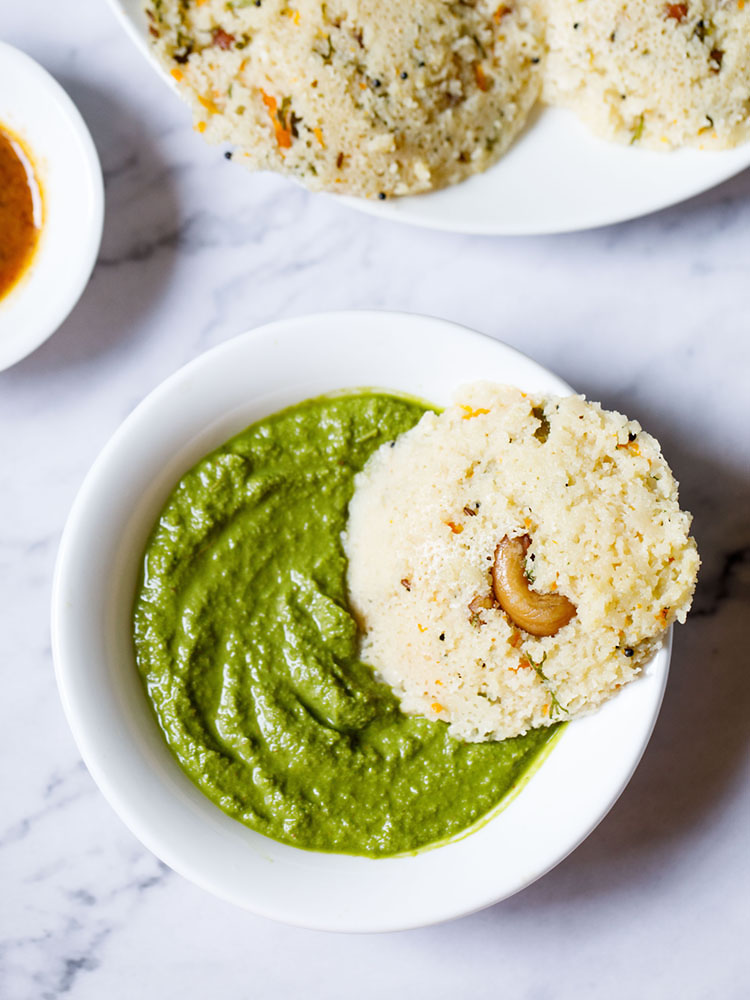
About Rava Idli
Being an idli and Dosa lover, I never say no to the different varieties of both these quintessential South Indian preparations. This recipe of Rava Idli is a tried and tested formula of making really good idlis from cream of wheat or semolina at home.
Also known as Suji Ki Idli (in Hindi) it is a soft, pillowy steamed savory cake made from rava or suji and is a popular variation of the traditional South Indian idli which is made with fermented rice and lentil batter.
‘Suji’ in Hindi, also referred to as ‘rava’ and ‘cream of wheat’ or ‘semolina’ in English, is basically ‘granulated wheat.’
Once you try this Rava Idli, you’ll know that it is equally fantastic and just as amazing as its classic counterpart.
Sometimes, I feel this one is actually better as it brings in a change from you regular idlis. It is always great to have something different, on a daily basis.
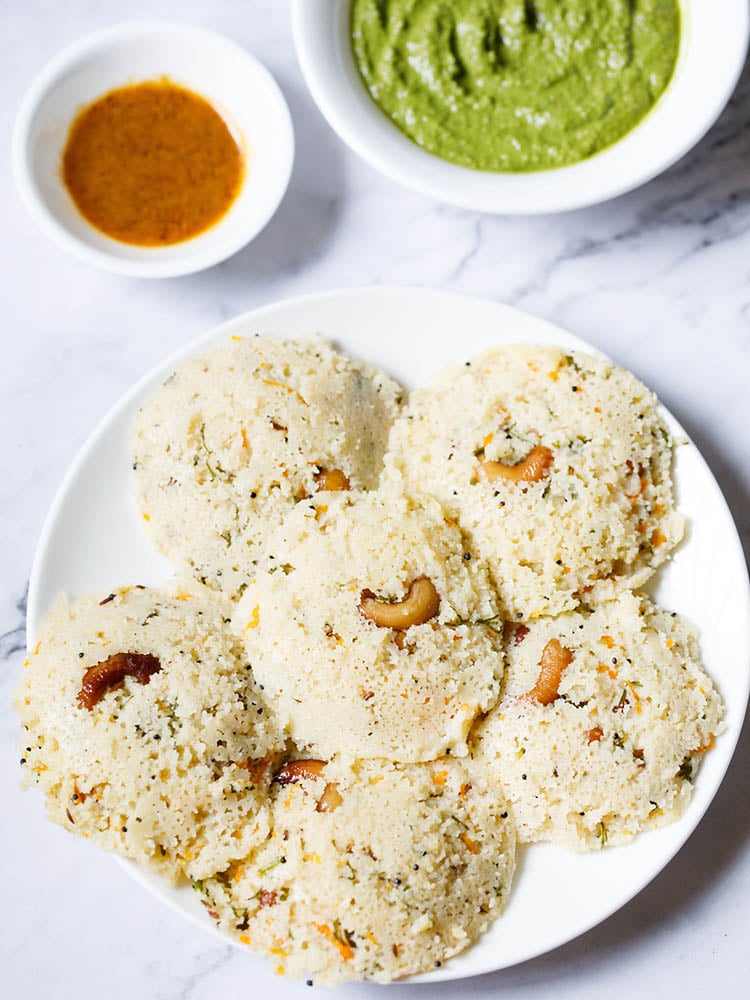
To elevate the nutrition quotient and make a more wholesome dish, I also add some grated carrots in the batter of this Suji Ki Idli.
It also makes the idlis look pretty with specks of orange in them after getting steamed. However, this is not essential and you can skip adding it, if you wish to.
In addition to the carrots, my recipe of Rava Idli also has fried cashews in it. I add a fried cashew in each compartment of the idli stand and then pour the batter in them.
Once steamed, the fried cashew gives a really earthy flavor and texture to the idlis and makes them even more delicious.
About Rava Idli Recipe
Rava Idli recipe is made by mixing ghee roasted rava or suji (cream of wheat) with curd (yogurt), spices, herbs, water and a leavening agent like baking soda or fruit salt (Eno) to make a nice batter of medium consistency.
The reaction of alkaline fruit salt or baking soda with the acidity of the curd helps in leavening the batter. Thereby, giving it a soft and fluffy texture. This flavorful batter is then steamed in an idli maker to make fluffy, pillowy cakes or Rava Idli.
Traditionally, idlis are made of rice and lentils, which involves soaking the rice and lentils for 4 to 5 hours as well as grinding them and then fermenting the batter.
As this recipe of Suji Ki Idli uses suji (cream of wheat), yogurt and a leavening agent instead, all that soaking or grinding time gets eliminated. Thus, making this an easy, instant recipe without any fermentation.
For that reason, I make Rava Idli when I want some quick and easy breakfast or snack. This idli batter gets done within minutes and then, as the idli is steaming, I prepare the coconut chutney, which is the traditional dip to serve with idli.
How to make Rava Idli
Fry Cashews, Spices & Lentils
1. Heat 2 tablespoons ghee in a pan. Keep the heat to low or medium-low and add 14 halved cashews.
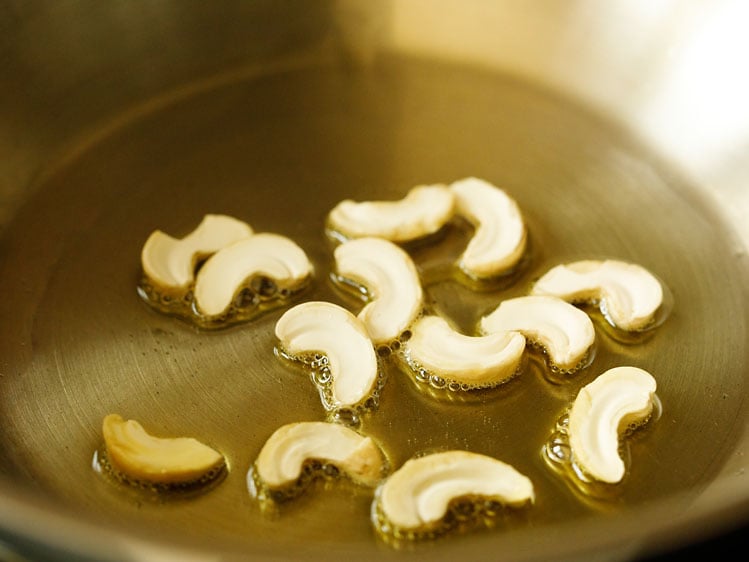
2. Stirring often, fry the cashews till golden. Remove with a slotted spoon draining the ghee and keep aside. Reduce the heat to low or medium-low.
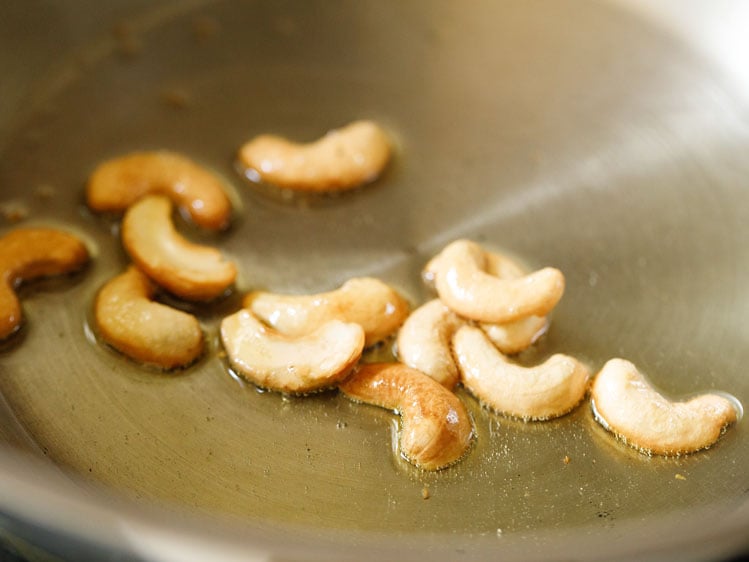
3. To the same pan, add ½ teaspoon mustard seeds. Let the mustard seeds begin to splutter.
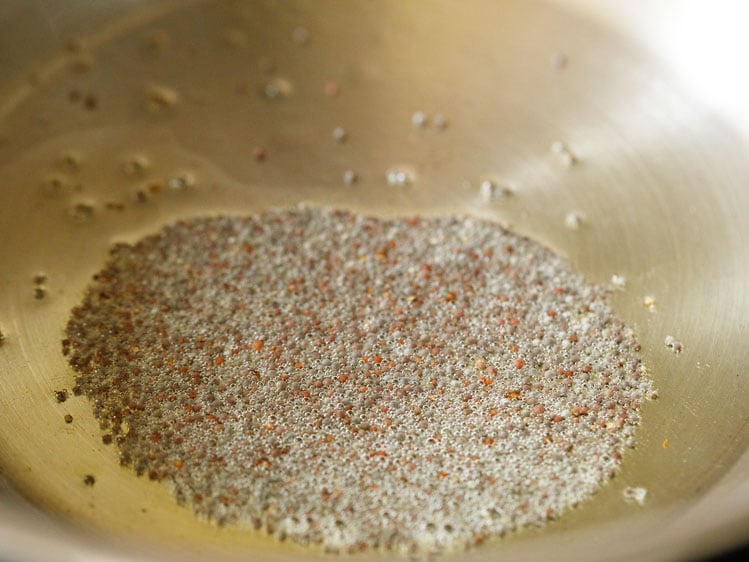
4. Add 1 teaspoon husked and split Bengal gram (chana dal).
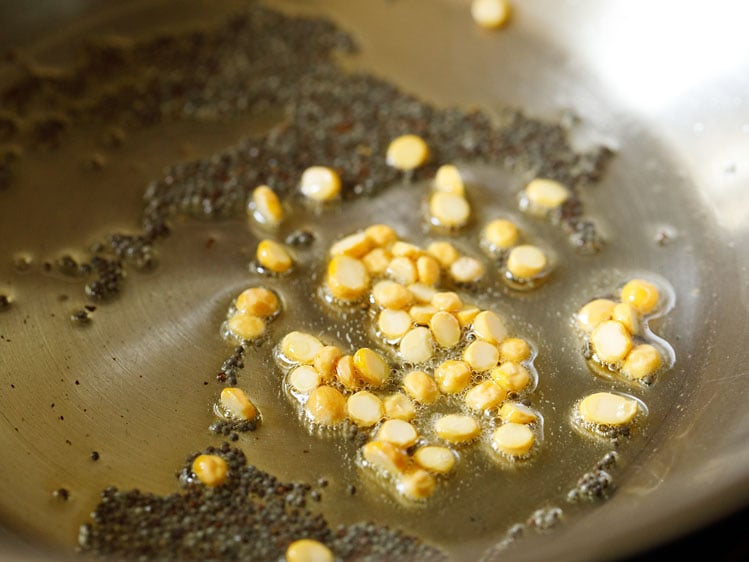
5. Stirring often, fry chana dal till golden and crunchy. Then, add ½ teaspoon cumin seeds and fry for 4 to 5 seconds.
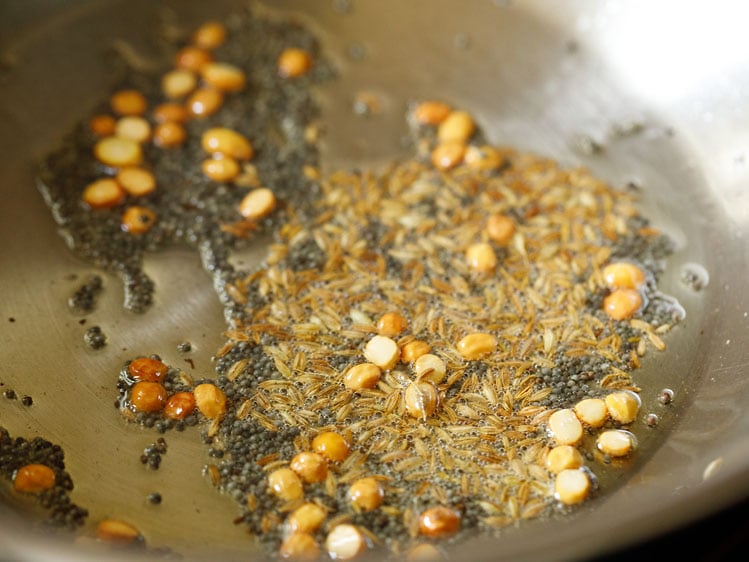
6. Now, add 10 to 12 chopped curry leaves, 1 pinch asafoetida (hing), 1 teaspoon finely chopped ginger and 1 finely chopped green chili (about ½ to 1 teaspoon chopped).
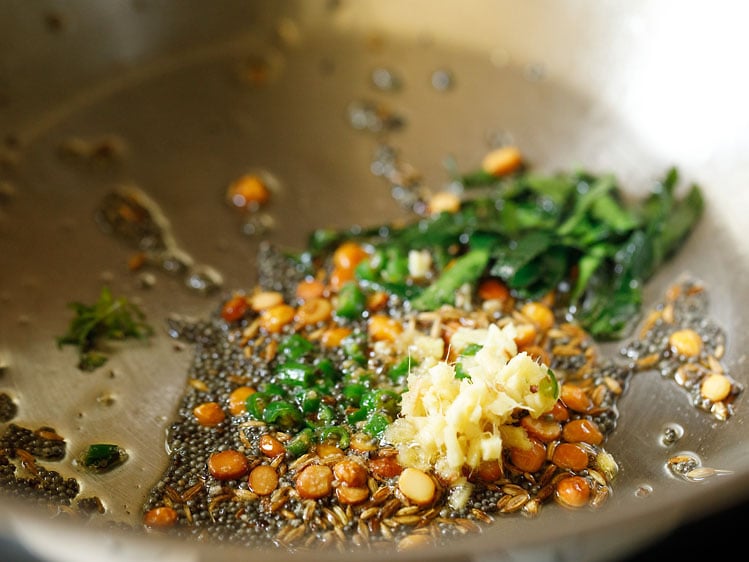
7. Mix well and fry for about 10 seconds. Keep the heat to a low.
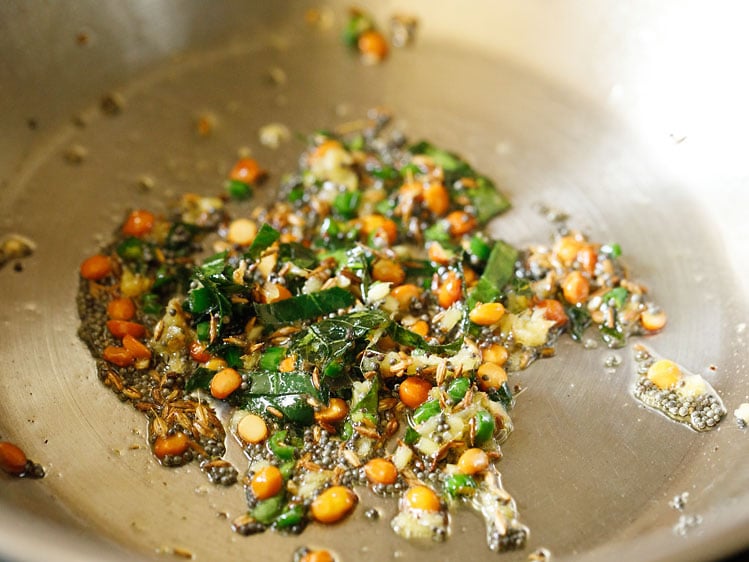
Make Rava Idli Batter
8. Now, add 1 cup rava or suji (finer variety of cream of wheat or semolina).
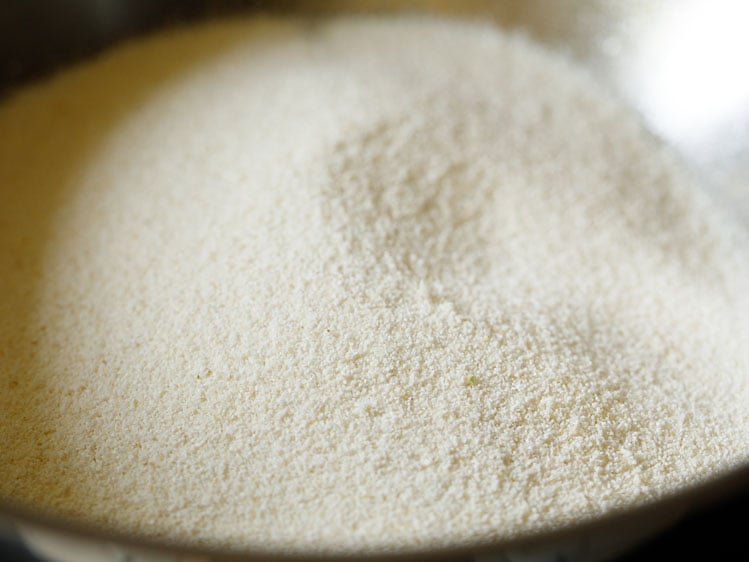
9. Mix the rava very well with the ghee and other ingredients.
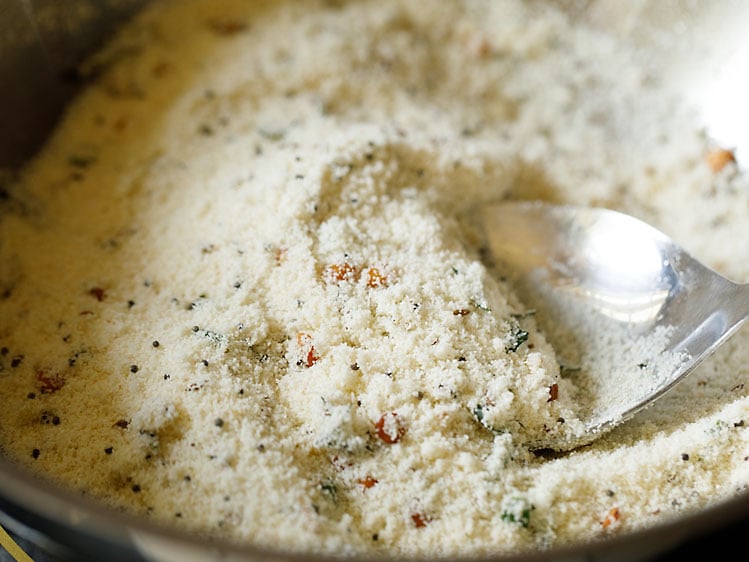
10. Roast rava till it become aromatic, changes color a bit (but should not get browned or golden) and the grains look separate. Stir often.
Roasting rava takes about 5 to 7 minutes depending on the thickness and heaviness of the pan and the heat intensity.
Once the rava is well roasted, keep the pan aside. Let the rava become warm.
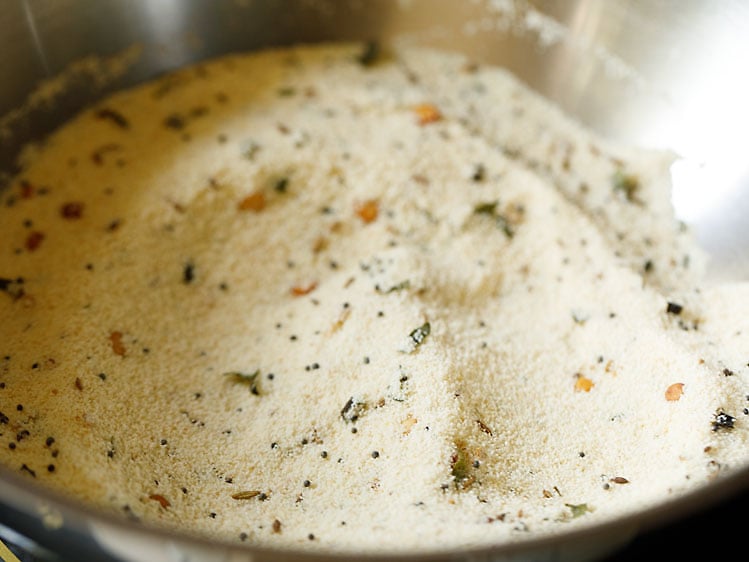
11. To the roasted rava, add 2 tablespoons finely grated carrots, 2 tablespoons chopped coriander leaves and ½ teaspoon salt or as required.
If adding any other grated vegetables or steamed green peas, then add them at this step.
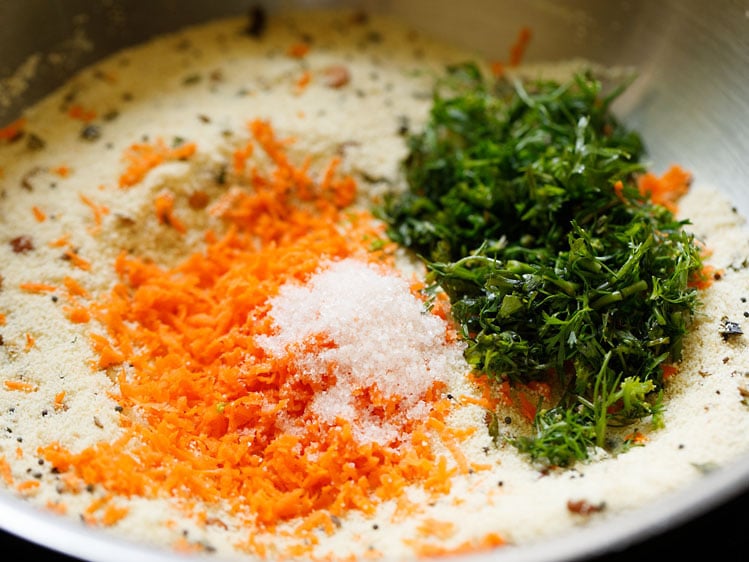
12. Next, add ½ cup curd (yogurt) and ½ to ¾ cup water. Depending on the quality of rava and the thickness of curd, you can adjust the water.
Tip 1: If the curd is liquid and has whey in it, then add ½ cup water.
Tip 2: If the curd is very thick, then add ¾ cup water. Basically, you need to get a medium consistency batter.
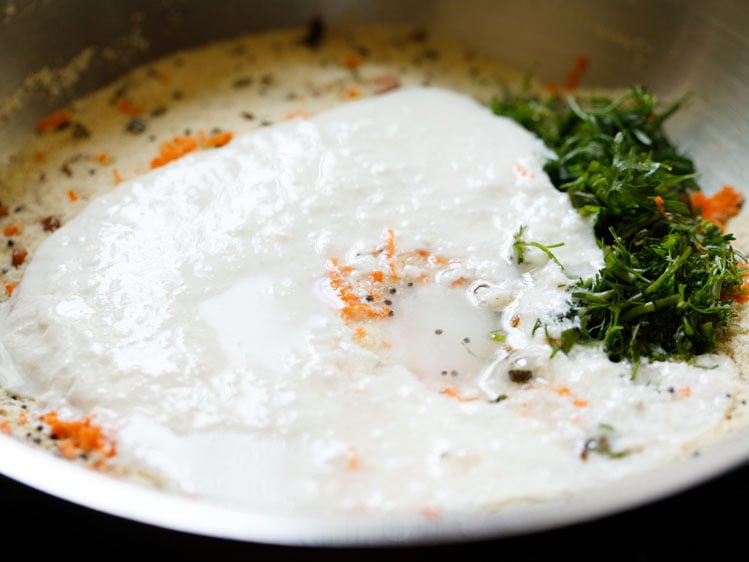
13. Mix very well and let the batter rest, covered for 20 minutes. The idli batter is neither thick, nor thin in consistency. It has a medium consistency.
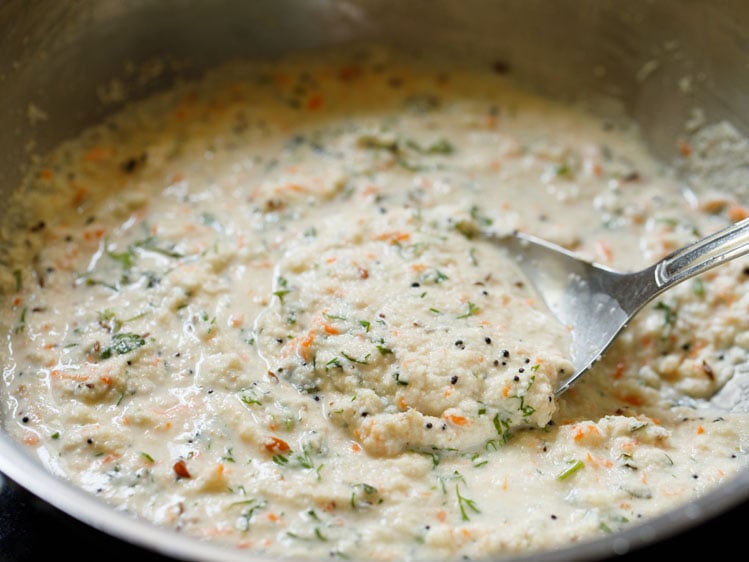
More Prep
14. Brush oil or ghee on the idli moulds. Place a fried halved cashew in the center of the moulds.
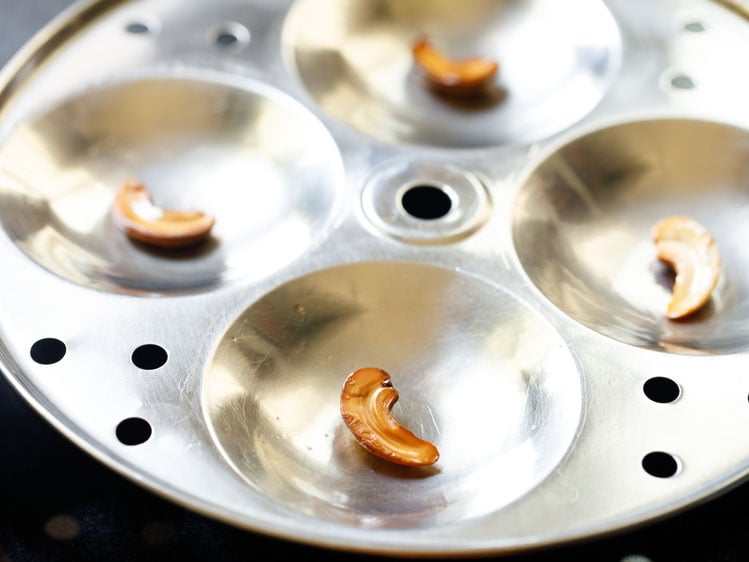
15. Before you add fruit salt (Eno) or baking soda to the batter, take 2 to 2.5 cups water in a pot.
Keep a small length trivet stand or a rack in the pot. Heat the water till it comes to a boil.
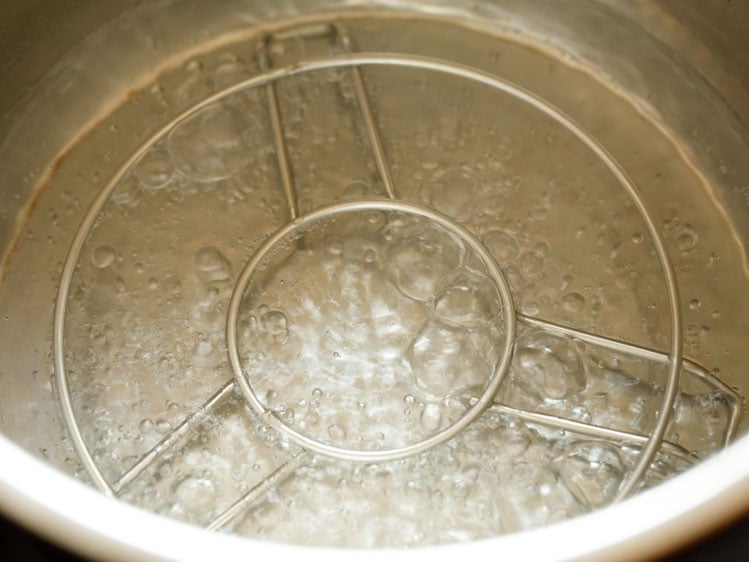
16. After 20 minutes, this is the consistency of the batter. In case the batter looks thick, add 1 to 2 tablespoons water to get a medium consistency.
Rava absorbs water. So, the batter might thicken after 20 minutes. If the curd is thick, then also you may need to add more water.
In case you have added more water in the beginning, you do not need to add any water at this step.
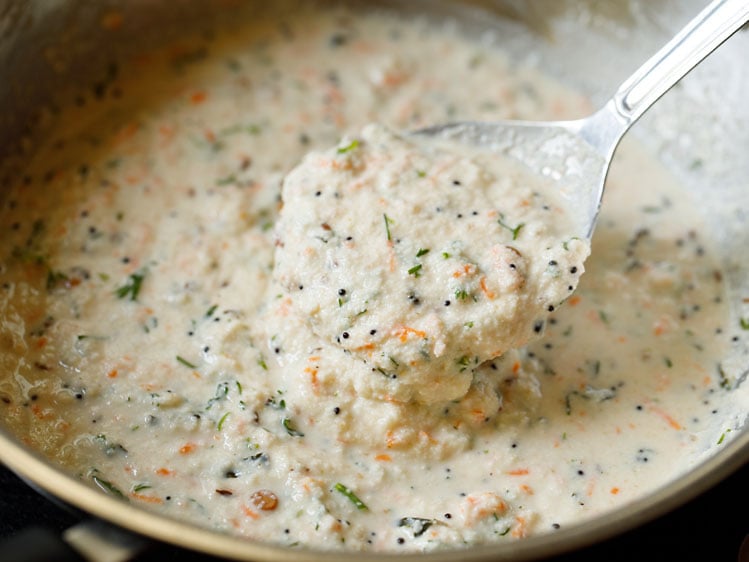
17. Sprinkle 1 teaspoon fruit salt (Eno) or ¼ teaspoon baking soda evenly over the batter. I have used Eno.
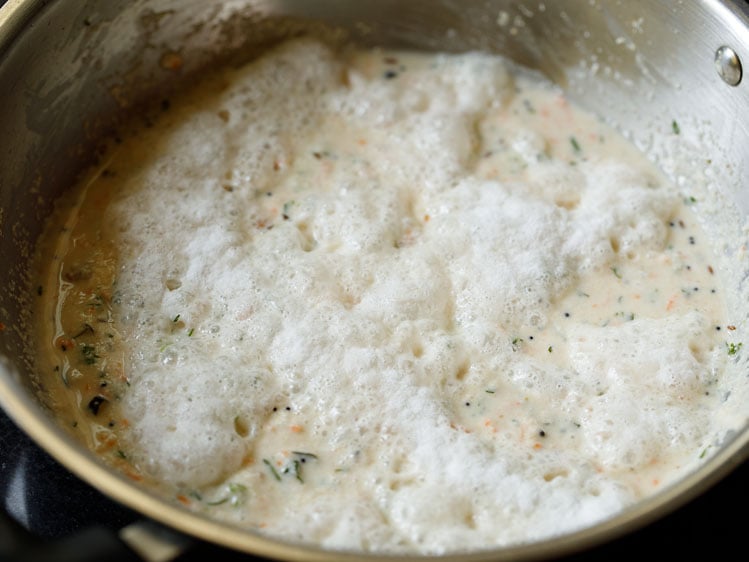
18. Mix very well, quickly.
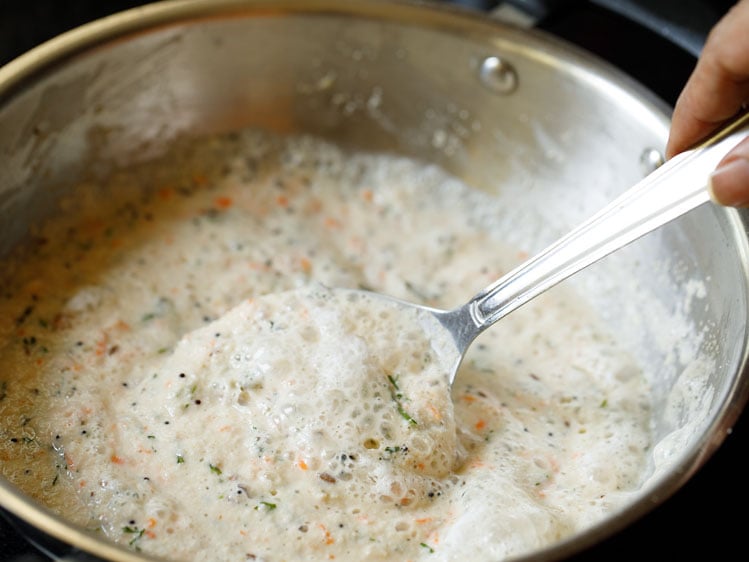
Make Rava Idli
19. Pour the batter in the greased idli moulds.
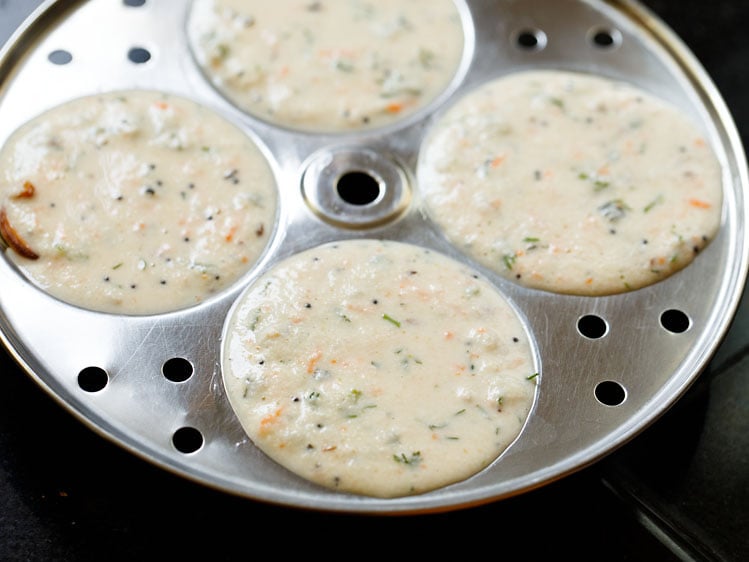
20. Stack each idli plate and place them in the pot with the hot water. Cover with a lid and steam Suji Ki Idli for 10 to 12 minutes on medium heat.
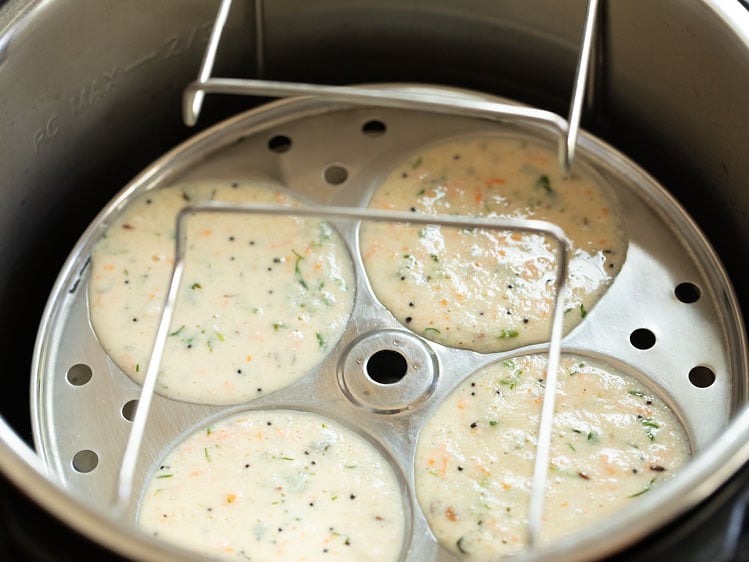
21. I have used the Instant Pot for steaming and had set the time for 10 minutes (check notes section in recipe card on finer details for steaming in the IP as well as pressure cooker and pan).
Keep a stop-watch or timer to check the time as Instant Pot does not beep in the steaming mode after the steaming time is over. It will continue to steam further.
You can even steam idlis in an electric cooker, pan or pressure cooker for 10 to 12 minutes.
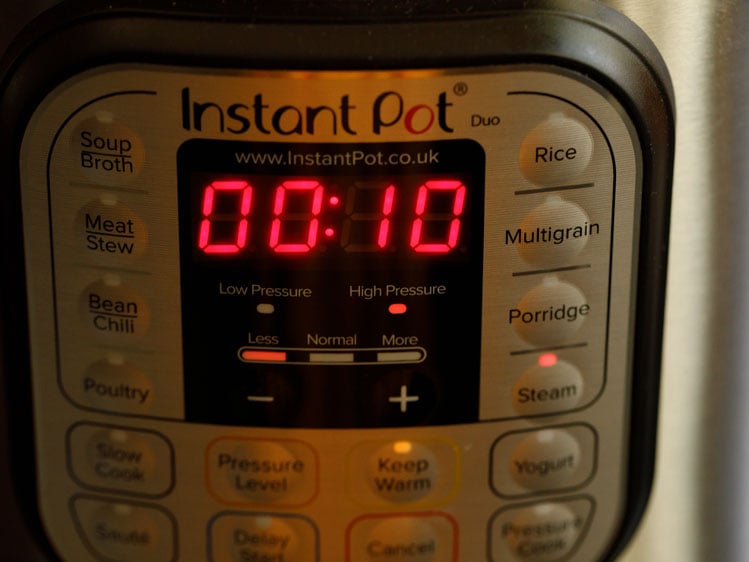
22. To check the doneness, a bamboo skewer or a fork inserted in the steamed idlis should come out clean.
Remove the idli plates carefully and let them rest for 3 to 4 minutes. Then, with a spoon remove the idlis.
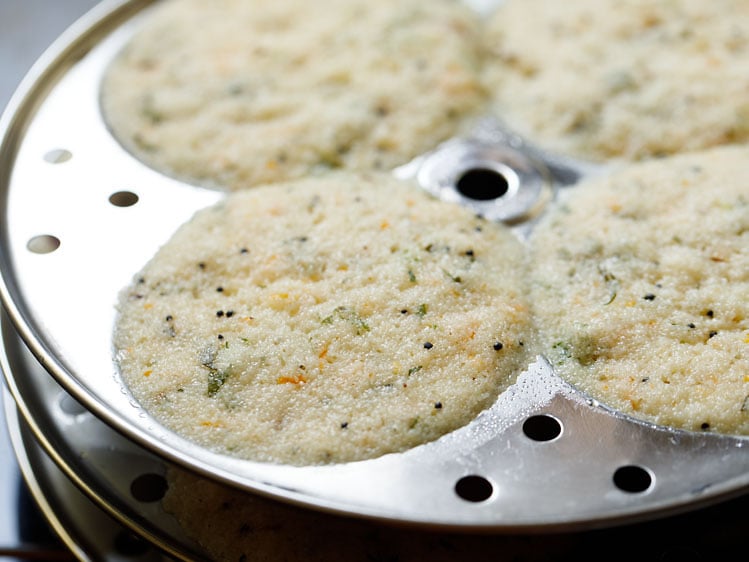
23. Serve Rava Idli hot with sambar, coconut chutney or coriander coconut chutney.
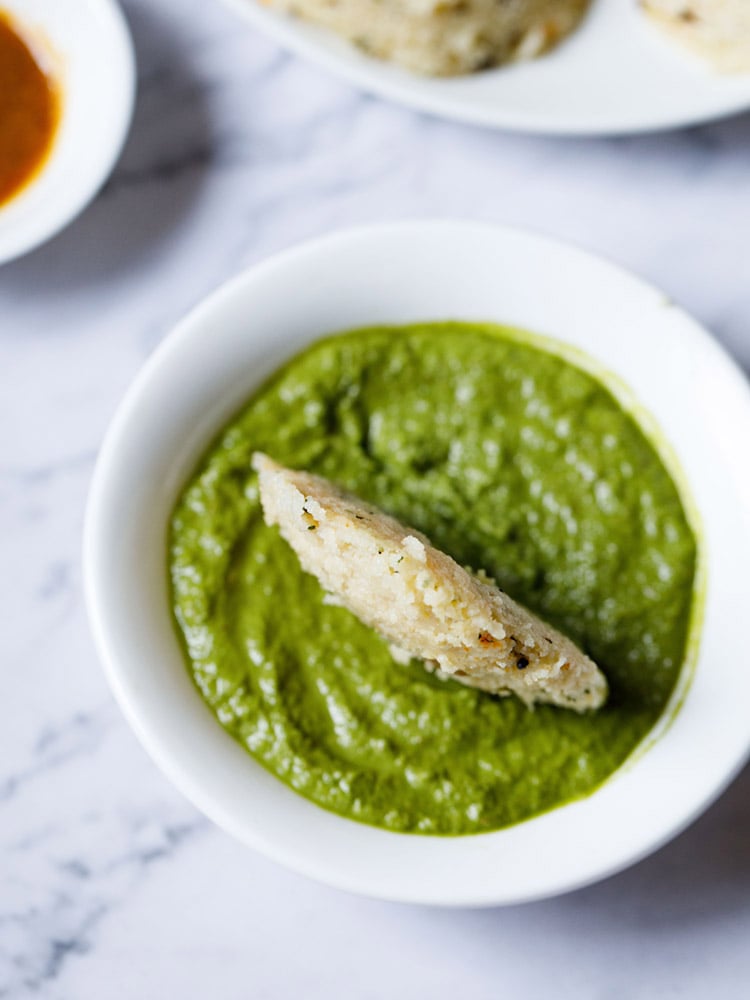
Serving Suggestions
Here are some of the common as well as some not so common ways that you can serve the Suji ki Idli. Check them out:
- Coconut Chutney: Rava Idli tastes the best with the classic coconut chutney or a Coriander Coconut Chutney too.
- Sambar: These idlis made with rava also taste good with a sambar – a traditional South Indian vegetable stew cooked with lentils, vegetables and tamarind.
- Potato Sagu: Rava Idli and potato sagu – a lightly spiced potato curry from the cuisine of Karnataka – is a great combination.
- Idli Podi: Idli podi makes for a fabulous side with Rava Idli. It is a dry powder made with lentils and dried red chilies and has a spicy, earthy flavor along with a slight crunchy texture. Sesame oil or ghee is mixed with the podi to make a yum paste that is served with the idlis.
Expert Tips
- Leavening Agent: 1 teaspoon of fruit salt (Eno) is perfect for the amount of rava and curd used in the recipe. Results in soft, fluffy idlis without the soapy aroma. If you use baking soda, add ¼ teaspoon (2 to 3 pinches) of it in the batter. The spices and herbs also add a lot of flavoring of their own in the recipe.
- Vegetables: I have added some grated carrots to the batter, which you can skip. You can even add steamed green peas. Just boil the peas beforehand and also grate the veggies ahead of time so they are ready to be added. You can also also include grated beets or finely shredded cabbage or finely chopped bell peppers.
- Curd (yogurt): I have used fresh curd. Both fresh or sour curd can be used to make the idli. Another variation of idli is this idli made with rice rava where cream of rice is used, instead of cream of wheat.
- Water: In case the curd you are using is thin and runny with lots of whey in it, add ½ cup water. If it is very thick, then add ¾ cup water. Adjust the quantity of batter to get a medium consistency batter.
- Idli pan: You will need an idli pan to make these steamed cakes. Idli pans are made to fit perfectly into a pressure cooker or steamer. If you can’t find an idli maker in the market, you can always order one online from Amazon.
FAQs
The fine variety of rava, not coarse. You can use Bombay or chiroti rava.
Eno or baking soda should be fresh and within their shelf period. If not fresh or active, they won’t leaven the batter, resulting in hard idlis. Also, the moment you mix in Eno, steam the batter immediately. If you keep the batter resting, the idlis won’t fluff.
Yes. Roasting rava coats the fine rava grains with ghee, which helps in giving a light texture to the idlis, without being sticky or gluey.
Yes. But add as much of it, till you get a medium consistency batter.
You can skip. But then the idlis won’t have a fluffy texture. They will be soft though, with a slight denseness.
Yes, you can. But add Eno or baking soda just before steaming. The batter will also thicken. So, add a few tablespoons of water and mix well before steaming.
No. Baking powder is not an alternative to baking soda or fruit salt. You will need to add more quantity of baking powder. This will result in metallic and bitter tasting idlis.
You can use a pan or bowl for steaming.
Adding more of the leavening agent gives a crumbly texture.
Not roasting the rava well and too much water can result in stickiness.
Less water and prolonged steaming will give a dry and denser texture.
More South Indian Breakfast Recipes To Try!
Breakfast Recipes
Breakfast Recipes
Breakfast Recipes
Breakfast Recipes
Please be sure to rate the recipe in the recipe card or leave a comment below if you have made it. For more vegetarian inspirations, Sign Up for my emails or follow me on Instagram, Youtube, Facebook, Pinterest or Twitter.
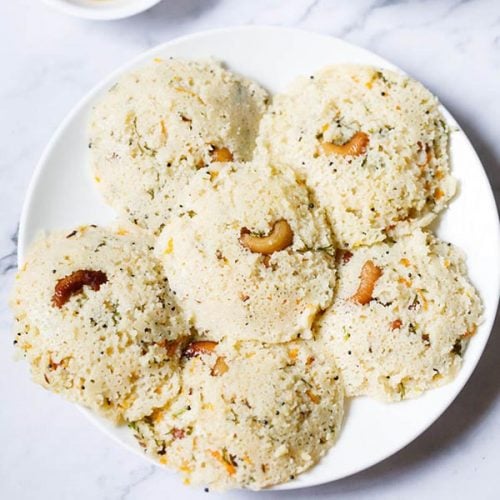
Rava Idli (Easy and No Fermentation)
Ingredients
For frying & roasting
- 2 tablespoons Ghee (clarified butter)
- 7 to 8 cashews – halved
- ½ teaspoon mustard seeds
- 1 teaspoon chana dal (husked and split bengal gram or split & husked chickpeas)
- ½ teaspoon cumin seeds
- 10 curry leaves – chopped
- 1 pinch asafoetida – optional
- 1 teaspoon ginger – finely chopped or 1 inch peeled ginger
- 1 green chilli – finely chopped or ½ to 1 teaspoon, chopped
For batter
- 2 tablespoons carrots – finely grated, optional
- 2 tablespoons coriander leaves – chopped, (cilantro)
- ½ teaspoon salt or add as required
- 1 cup rava – 175 grams (sooji, semolina, cream of wheat)
- ½ cup Curd (yogurt)
- ½ to ¾ cup water or add as required
- 1 teaspoon eno (fruit salt) or ¼ teaspoon or 2 to 3 pinches of baking soda
Instructions
Preparation
- Heat 2 tablespoons ghee in a pan. Keep the heat to low or medium-low. Add the halved cashews.
- Stirring often fry the cashews till golden. Remove fried cashews with a slotted spoon draining the ghee and keep aside.
- To the same pan add mustard seeds and let them begin to splutter. Keep the heat to low or medium-low.
- When the mustard seeds begin to splutter add the chana dal. Stirring often fry chana dal till they look golden and crunchy.
- Then add the cumin seeds and fry for 4 to 5 seconds.
- Now add the chopped curry leaves, asafoetida, finely chopped ginger and green chillies. Mix well and fry for 10 seconds. Keep the heat to a low.
- Next add rava (cream of wheat, suji, semolina).
- Mix well and stirring often roast the rava till they become aromatic, change color a bit (but should not get browned or golden) and the grains look separate.
- Roasting rava will takes about 5 to 7 minutes depending on the thickness and heaviness of the pan, and the flame intensity.
- Once the rava is well roasted, keep the pan aside. Let the rava become warm.
Making Batter
- To the roasted rava, add finely grated carrots, chopped coriander leaves and ½ teaspoon salt or add as required.
- Next add curd (yogurt) and water as required. Depending on the quality of rava and the thickness of curd, you can adjust the water from ½ to ¾ cup.
- If the curd is liquid and has whey in it, then add ½ cup water. If the curd is very thick, then add ¾ cup water. Basically you need to get a medium consistency batter.
- Mix very well and let the batter rest covered for 20 minutes. The rava idli batter is neither thick nor thin in consistency and has a medium consistency.
- Brush oil or ghee on the idli pan moulds. Place a fried halved cashew in the center of the moulds.
- Also heat 2 to 2.5 cups water in a pot. Keep a small length trivet stand or a rack in the pot. Heat the water till it comes to a boil.
- After 20 minutes this is the consistency of the batter after resting. If in case the batter looks thick, rava idli batter looks thick, then add 1 to 2 tablespoons of water to get a medium consistency.
- Rava absorbs water and so the batter might thicken after 20 minutes. If the curd is thick, then also you may need to add more water. If you have added more water in the beginning, then you may not need to any water at this step.
- Sprinkle 1 teaspoon eno or ¼ teaspoon baking soda evenly over the batter. Quickly mix very well.
Steaming Rava Idli
- Pour the batter in the idli moulds. Place them in the pot with the hot water. Cover with a lid and steam rava idli for 10 to 12 minutes on medium heat.
- To check the doneness, a bamboo skewer or fork inserted in the rava idli should come out clean. Remove the idli plates carefully and let them rest for 3 to 4 minutes. Then with a spoon remove the rava idli.
- Serve the steaming hot rava idli with sambar and your favorite coconut chutney.
Video
Notes
- Type of rava: Kindly use the finer variety of rava and not the coarser or bigger ones. You can use bombay rava or chiroti rava.
- Roasting rava: The rava has to be roasted well in ghee so that they do not become sticky after steaming.
- Leaving agents: Eno (fruit acid) and baking soda are the leaveing agents used in the recipe. You can add either of them. Do make sure they are fresh and within their shelf period. If they are not fresh or active, they won’t leaven the batter resulting in hard rava idli.
- Skipping the leavening agents: You can skip them, but the rava idli won’t have a fluffy texture. They will be soft though with a slight denseness in the texture.
- No idli pan, no problem: Use a cake pan or bowl for the batter and steam. Once steamed well, then slice in wedges or cubes.
- Steaming: Do not steam for a prolonged time as this will result in dense rava idli. You can easily steam in a pan, instant pot or a pressure cooker.
- Steaming in a pan: Heat 2.5 cups water in a large pot or pan. Place a small trivet stand. Then place the idli pan on the trivet. Cover with a lid loose enough to let the steam pass or with a vent. Steam for 10 to 12 minutes.
- Steaming in a pressure cooker: Heat 2.5 cups water in a 5 or 6 litre pressure cooker. Place the pressure cooker grid plate inside the water before heating it or a small trivet. Keep the idli pan. Remove the vent weight (whistle) from the lid. Seal the pressure cooker with its lid. Steam for 10 to 12 minutes.
- Steaming in Instant Pot: Add 2 to 2.5 cups water in the steel insert of a 6 quart IP. Place a small trivet in the water. Using the sauté option bring the water to a boil. Press cancel. Place the idli plates. Cover with the IP lid and keep the sealing position to vent (so that the steam is released from the vent during the entire process of steaming). Press the steam button on high and set the time to 10 minutes. Use a stop watch to check the time.
- Note that the approximate nutrition info is for 1 rava idli.
Nutrition Info (Approximate Values)
This Rava Idli recipe from the archives first published in November 2013 has been updated and republished on February 2023.
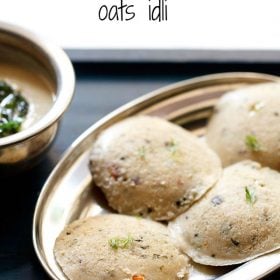
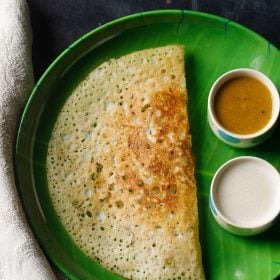
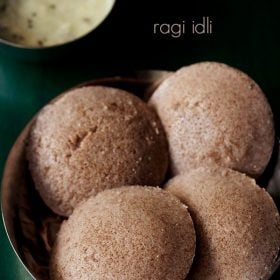
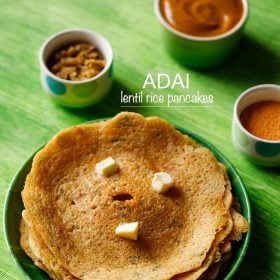












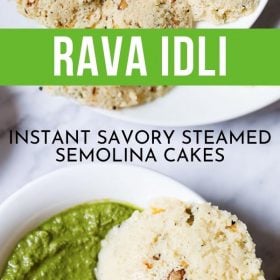
Hi Dassana, this is Sara hope you are in a good state, Let me tell you, your recipes are amazing, you explain it in a very easy way, you make it so easy for us to understand the best part is that you show in pictures step by step which no other person does.. Thanks alot for sharing your amazing delicious recipes. I love Veg Recipes of India 🙂
yes i am good sara. hope the same for you. thanks for the sharing your views on the presentation of the recipes. i am glad that you are liking the recipes. stay blessed and happy cooking.
Hi Mam,
This blog is so insipring. Can we totally avoid soda in this receipe please? What’s the impact? Pls let us know
thanks. you can skip soda. but the texture won’t be fluffy and light. they will be soft but with a slight denseness in them.
These rava idlis turned out great. I tripled the recipe and added just 1/4 tsp baking soda to the tripled recipe. The rava idlis fluffed up nicely. My husband and kids loved these soft and yummy rava idlis and kids wanted to packed it in their school lunch box too. Next time, I plan to add grated carrots and other veggies.
The rava idlis I had tried to make in the past have never come out well and even the ones I have eaten outside were not to my taste. I would never have tried to make rava idlis if not for the fact that all recipes I have tried from your site have turned out so good. After using many recipes from your site, I have started to like so many dishes which I didn’t use to like earlier. And that has made me more adventurous in cooking and trying dishes which I had an aversion too.
You really have magic in your fingertips to bring forth the best with ingredients. Keep up the great work.
thanks deepa for this detailed comment. this recipe can be easily doubled or tripled. of course you can add some grated veggies. it tastes very good with some grated carrots, capsicum and peas.
usually whenever we have a dislike for some dish, its because we have not got the correct taste and flavor of that particular dish. had we eaten the dish the way it is made, one would not have a dislike or aversion. i knew someone who had an aversion to thai curries. but when i made it, he really liked it and said it was different than what he had eaten. if the recipe is made correctly and rightly with the correct method and technique, then the aversion or dislike won’t be there as you will get to have the authentic and real taste of the dish.
its the blessings of the goddess that gives the magic and helps me to create good recipes.
Thank you very much for the recipe. The idlis came out very well. I took a short cut by roasting rava along with the tempering. Thank you once again.
Welcome Rohini. Nice to know this.
Very soft and deliscious idlis. Thank you for sharing your recipe. I made it in the microwave and apart from it being very slightly crumbly, it was perfect.
Welcome Shruti. Glad to know this. Thanks for your positive feedback on rava idli.
Thank you for this recipe… The rava idlis came out really well.. One of those rare days when my son completed his tiffin and also told me he liked it… made my day!!! 🙂
welcome priya. nice to know that your son liked the idlis. thanks for sharing.
Hello, simple recipe, the rava idlis came out well! I added 1/4 tsp baking soda to the batter.
Thanks Binu. Good to know this.
tried this and it came out awesome !
I didn’t expect this much of softness with an instant idly not to forget that too with sooji coz my oats instant idly with cracked wheat always turns out awesome but when I substitute cracked wheat with sooji NOPE ..
Thanks for the wonderful recipe
Welcome Shobana. Rava Idli turns out soft, if made properly. Glad to know that you liked this idli recipe.
Very Excellent recepie rava idli
Thanks Rambabu
Hi Dassana,
How are you?. Wanted to ask that is it fine to add eno/baking soda when making this rava idli for 4 yr and 1.5 year old kids . I had sooji at home so got interested to make this idli but when I saw eno…i stopped there itself and didn’t go ahead with the recipe coz there’s no point in going through it if its not useful for kids…btw…why do we add eno?
teena, i am good. eno or baking soda is added to give some porousness, lightness and softness in the idlis. otherwise the idlis become dense and slightly hard. since i have made rava idlis without adding eno or baking soda, i know how the texture is. since the batter is not fermented overnight there is no leavening happening in it. for the leavening action to happen eno or baking soda is used. if eno is your concern, then you can still skip it but the idlis will have some denseness in them.
Hi Dassana,
Last night I Just kept the mixture ready… Morning I added curd and followed ur
instructions.
Rava idli turned out super delicious… Thanks for the recipe… I made tomato chutney and peanut chutney too..
Appreciate your effort.
Thanks
Welcome Vidya. Glad to know that you liked the rava idli recipe and they came out super delicious.
Hi dasanna
Pls help my idly dint turn soft wat could have gone wrong
dipica, could be due two reasons. one is less water in the batter and second reason is baking soda/eno not fresh. you can also try increasing the baking soda than what is mentioned in the recipe. hope this helps.
I loved your recipe for instant rawa idli. I often make them in breakfast. They turn out really well as they are soft and fluffy. Thank you for this time saver and delicious idea.
Welcome Aarti. Thanks for your positive feedback.
Hi
This post comes really late but I cant thank you enough for your recipes .I have been using your site past 4-5 yrs probably more after my marriage because I get bored with routine food very soon and like making experiments,everytime I do a google search and there your website comes up in the list first .Whatsoever be the reason my food with your recipes have always turned out good.I follow your post dedicatedly with respect to measurements too.Its so much fun cooking and knowing that it wont fail because your recipes are always tried and tested ones .Even my yesterday s attempt at Rava Idli came out tasty and my hubby who said I dont want to eat Rava Idli , ate it admiring it that its so nice and soft.
Thanks Once Again and Keep your recipes coming.
Welcome Supriya. Thanks for sharing this awesome feedback. Glad to know that recipes are helping you in cooking.
You are doing an absolutely fantastic job at guiding all curious cooks Dassana Amit. All your recipes are easy to follow and explained in the most simplified manner even for amateur cooks. Keep up the great job.
Thanks Betty for your kind words and positive feedback. Loved reading your comment.